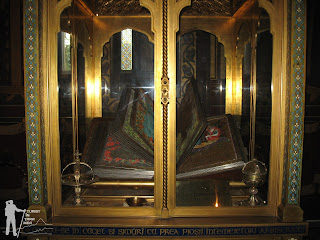Construcţia Mânăstirii Curtea de Argeş, ctitoria lui Neagoe Basarab (1512-1521), este lucru de legendă: Legenda Meşterului Manole, cel care împreună cu "nouă meşteri mari, calfe şi zidari" au ridicat "mânăstire-naltă, cum n-a mai fost alta". Interesant este că şi vecinii noştri sârbi sau bulgari au variante, de exemplu la sârbi este vorba de construcţia unei cetăţi.
Poate pentru că această mânăstire era cea mai frumoasă din ţară, şi aflându-se într-o stare foarte proastă, Regele Carol I a ordonat restaurarea ei, şi transformarea în necropolă domnească de către arhitectul francez Lecomte du Noüy.
Mai puţin cunoscut este faptul că biserica nu era gata la moartea lui Neagoe Basarab: ea a fost pictată de zugravul Dobromir din Târgovişte în timpul domniei lui Radu de la Afumaţi, al cărui mormânt cu lespede sculptată se află în stânga naosului. Acest domnitor a purtat în scurta domnie de doar 7 ani nu mai puţin de 20 de lupte cu turcii, găsind răgaz şi pentru înfrumuseţarea mânăstirii, devenind astfel al doilea său ctitor. Pictura originală a fost înlocuită în secolul 19 (cele mai valoroase fragmente fiind păstrate la Muzeul Naţional de Artă), pe pereţi fiind pictate perechile voievodale şi regale Neagoe Basarab - Despina, Radu de la Afumaţi - Ruxandra şi Carol I - Elisabeta.
Curtea de Argeş Monastery
There is a legend on the construction of Curtea de Argeş Monastery during the reign of Prince Neagoe Basarab (1512-1521). Ten master architects have raised the monastery. Originally, it kept on collapsing. Manole, the lead architect, dreamt that they should sacrifice a beloved one by walling her alive in oder to succeed in their work. They agreed that the first of their wives who shall bring the meal that day should be the chosen one. Unfortunately, it was Manole’s own beautiful and diligent wife, Anne, who arrived first. He had to keep his word so they walled her in, leaving a space at chest level just large enough for her to be able to breastfeed her child a few days more. It is interesting to know that Bulgariand and Serbs and possibly other Balkan people have variations of this legend. The Serbian version is about the construction of a fortress.
The monstery was built and endured the centuries. It must have really impressed Prince Carol I for he chose it as royal necropolis and had it restored by French architect Lecomte du Noüy.
It is less known that the monastery was not finished at the time when Prince Neagoe Basarab died: its painting was performed by Dobromir of Târgovişte during the reign of Radu of Afumaţi (1522-1529) who is burried there. His tombstone shown him riding into battle for he has waged no less than 20 battles with the Turks in his short reign, finding time also to finish the monastery. The original painting was replaced in the 19th century with part of it being kept in the National Art Museum. The princely and royal couples can now be admired at Curtea de Argeş Monastery: Neagoe Basarab - Despina, Radu of Afumaţi - Ruxandra and Carol I – Elisabeta.












Comentarii
Trimiteți un comentariu